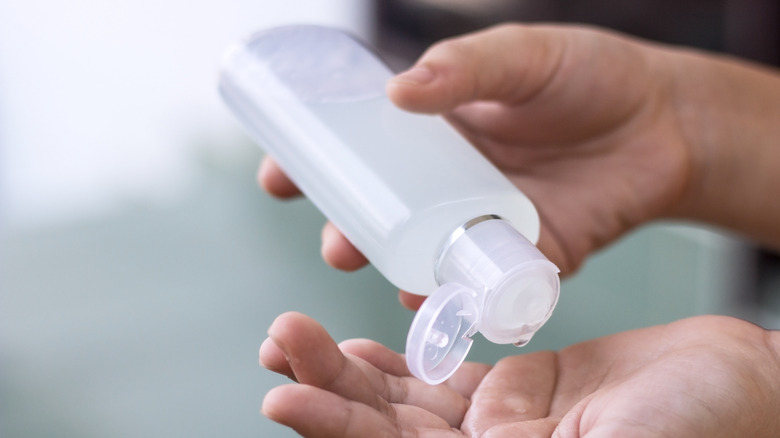
Can Hand Sanitizer Prevent The Spread Of Norovirus? We Explain – Health Digest
If you’ve ever come down with a stomach flu, many times it’s due to the norovirus. Norovirus isn’t really a flu, although it’s also highly contagious. The flu comes from an influenza virus and spreads when you inhale or touch infected respiratory droplets. The norovirus spreads through contaminated food (or touching contaminated surfaces) and causes abdominal symptoms such as vomiting, diarrhea, or stomach pain. You might also develop flu-like symptoms such as fever, body aches, and headache.
Just like with the flu and COVID, it’s important to wash your hands often to prevent the spread of norovirus. (Here are some hand-washing mistakes to avoid). You might think that hand sanitizer would be a convenient way to keep your hands clean, but the U.S. Centers for Disease Control and Prevention says that hand sanitizer doesn’t work very well against norovirus. A 2022 study in Frontiers in Microbiology tested eight commercially available hand sanitizers against one strain of norovirus. While hand sanitizers with a higher alcohol content (85% alcohol) can reduce norovirus more than others, they can’t completely wipe it out. Non-alcohol hand sanitizers made with benzalkonium chloride hardly worked at all.
Why hand sanitizers don’t work against noroviruses
Hand sanitizers became one of the hardest items to come by during the COVID-19 pandemic, selling out in stores and online. Hand sanitizer is pretty convenient when you don’t have access to some soap and clean water, and these days you’ll find hand sanitizers in entrances to building lobbies and medical offices. Hand sanitizers can be effective against enveloped viruses such as COVID-19 and influenza viruses. However, norovirus is a non-enveloped virus.
What’s a non-enveloped virus? Without getting too geeky, non-enveloped viruses lack a fatty outer membrane. Non-enveloped viruses are stronger and can damage your body’s tissues. Norovirus, enterovirus, adenovirus, and rhinovirus (your common cold) are examples of non-enveloped viruses. Non-enveloped viruses like norovirus are more resistant to extreme temperatures and basic disinfectants (per Virology Research Services).
That makes it difficult to control norovirus outbreaks. An outbreak occurs when two or more people are infected by the same norovirus exposure. The CDC says more than 2,500 norovirus outbreaks occur each year, more commonly during the winter months. You’ll often hear about norovirus outbreaks on cruise ships, but outbreaks can occur where people are closely gathered and sharing food, such as restaurants, catered events, schools, and healthcare facilities. The virus can survive on surfaces for days, according to Mass General Brigham.
How to prevent norovirus
Because hand sanitizer won’t work very well in killing norovirus, the CDC says you can protect yourself by keeping your hands clean using soap and water. You remember the drill from COVID days. You’ll need to wash your hands if you’ve changed diapers or used the toilet since the norovirus can show up in poop before you feel symptoms. Your hands should also be clean if you’re handling, preparing, or eating food. If you are sick, you shouldn’t prepare food for others for at least 48 hours after your norovirus symptoms stop.
Your countertops, kitchen utensils, cutting board, and other surfaces that come into contact with food should be sanitized often using bleach followed by soap and water. If you or a family member becomes sick with norovirus, use disposable gloves to handle any bed linens and clothing that might have vomit or poop on them. Wash these in the hottest water and use your highest dryer temperature. Noroviruses can withstand temperatures up to 145 degrees Fahrenheit.





